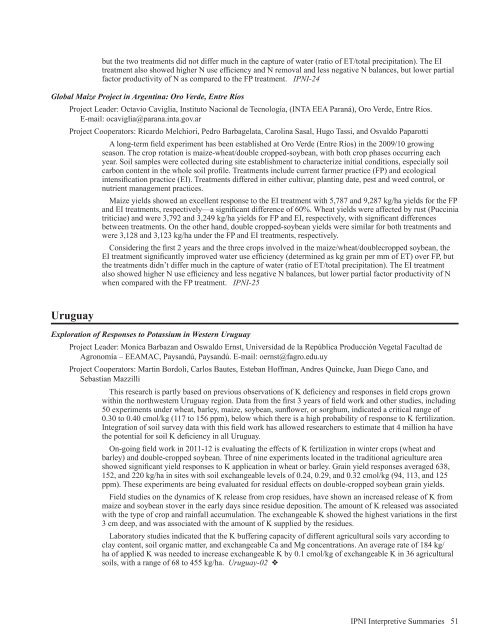Americas and Oceania Group - International Plant Nutrition Institute
Americas and Oceania Group - International Plant Nutrition Institute
Americas and Oceania Group - International Plant Nutrition Institute
Create successful ePaper yourself
Turn your PDF publications into a flip-book with our unique Google optimized e-Paper software.
ut the two treatments did not differ much in the capture of water (ratio of ET/total precipitation). The EI<br />
treatment also showed higher N use efficiency <strong>and</strong> N removal <strong>and</strong> less negative N balances, but lower partial<br />
factor productivity of N as compared to the FP treatment. IPNI-24<br />
Global Maize Project in Argentina: Oro Verde, Entre Ríos<br />
Project Leader: Octavio Caviglia, Instituto Nacional de Tecnología, (INTA EEA Paraná), Oro Verde, Entre Ríos.<br />
E-mail: ocaviglia@parana.inta.gov.ar<br />
Project Cooperators: Ricardo Melchiori, Pedro Barbagelata, Carolina Sasal, Hugo Tassi, <strong>and</strong> Osvaldo Paparotti<br />
A long-term field experiment has been established at Oro Verde (Entre Ríos) in the 2009/10 growing<br />
season. The crop rotation is maize-wheat/double cropped-soybean, with both crop phases occurring each<br />
year. Soil samples were collected during site establishment to characterize initial conditions, especially soil<br />
carbon content in the whole soil profile. Treatments include current farmer practice (FP) <strong>and</strong> ecological<br />
intensification practice (EI). Treatments differed in either cultivar, planting date, pest <strong>and</strong> weed control, or<br />
nutrient management practices.<br />
Maize yields showed an excellent response to the EI treatment with 5,787 <strong>and</strong> 9,287 kg/ha yields for the FP<br />
<strong>and</strong> EI treatments, respectively—a significant difference of 60%. Wheat yields were affected by rust (Puccinia<br />
triticiae) <strong>and</strong> were 3,792 <strong>and</strong> 3,249 kg/ha yields for FP <strong>and</strong> EI, respectively, with significant differences<br />
between treatments. On the other h<strong>and</strong>, double cropped-soybean yields were similar for both treatments <strong>and</strong><br />
were 3,128 <strong>and</strong> 3,123 kg/ha under the FP <strong>and</strong> EI treatments, respectively.<br />
Considering the first 2 years <strong>and</strong> the three crops involved in the maize/wheat/doublecropped soybean, the<br />
EI treatment significantly improved water use efficiency (determined as kg grain per mm of ET) over FP, but<br />
the treatments didn’t differ much in the capture of water (ratio of ET/total precipitation). The EI treatment<br />
also showed higher N use efficiency <strong>and</strong> less negative N balances, but lower partial factor productivity of N<br />
when compared with the FP treatment. IPNI-25<br />
Uruguay<br />
Exploration of Responses to Potassium in Western Uruguay<br />
Project Leader: Monica Barbazan <strong>and</strong> Oswaldo Ernst, Universidad de la República Producción Vegetal Facultad de<br />
Agronomía – EEAMAC, Pays<strong>and</strong>ú, Pays<strong>and</strong>ú. E-mail: oernst@fagro.edu.uy<br />
Project Cooperators: Martin Bordoli, Carlos Bautes, Esteban Hoffman, Andres Quincke, Juan Diego Cano, <strong>and</strong><br />
Sebastian Mazzilli<br />
This research is partly based on previous observations of K deficiency <strong>and</strong> responses in field crops grown<br />
within the northwestern Uruguay region. Data from the first 3 years of field work <strong>and</strong> other studies, including<br />
50 experiments under wheat, barley, maize, soybean, sunflower, or sorghum, indicated a critical range of<br />
0.30 to 0.40 cmol/kg (117 to 156 ppm), below which there is a high probability of response to K fertilization.<br />
Integration of soil survey data with this field work has allowed researchers to estimate that 4 million ha have<br />
the potential for soil K deficiency in all Uruguay.<br />
On-going field work in 2011-12 is evaluating the effects of K fertilization in winter crops (wheat <strong>and</strong><br />
barley) <strong>and</strong> double-cropped soybean. Three of nine experiments located in the traditional agriculture area<br />
showed significant yield responses to K application in wheat or barley. Grain yield responses averaged 638,<br />
152, <strong>and</strong> 220 kg/ha in sites with soil exchangeable levels of 0.24, 0.29, <strong>and</strong> 0.32 cmol/kg (94, 113, <strong>and</strong> 125<br />
ppm). These experiments are being evaluated for residual effects on double-cropped soybean grain yields.<br />
Field studies on the dynamics of K release from crop residues, have shown an increased release of K from<br />
maize <strong>and</strong> soybean stover in the early days since residue deposition. The amount of K released was associated<br />
with the type of crop <strong>and</strong> rainfall accumulation. The exchangeable K showed the highest variations in the first<br />
3 cm deep, <strong>and</strong> was associated with the amount of K supplied by the residues.<br />
Laboratory studies indicated that the K buffering capacity of different agricultural soils vary according to<br />
clay content, soil organic matter, <strong>and</strong> exchangeable Ca <strong>and</strong> Mg concentrations. An average rate of 184 kg/<br />
ha of applied K was needed to increase exchangeable K by 0.1 cmol/kg of exchangeable K in 36 agricultural<br />
soils, with a range of 68 to 455 kg/ha. Uruguay-02 v<br />
IPNI Interpretive Summaries 51

















